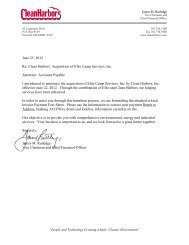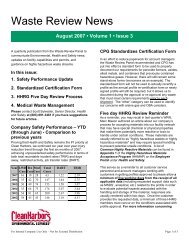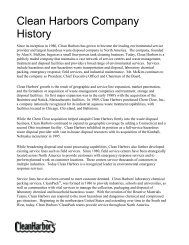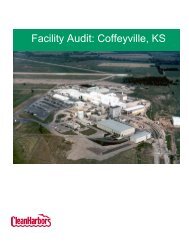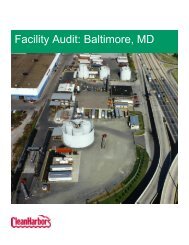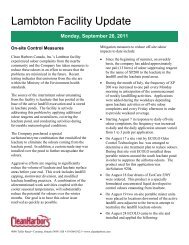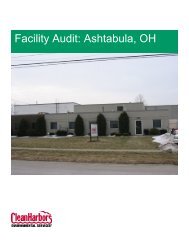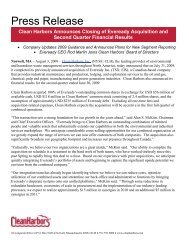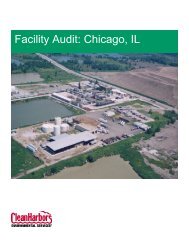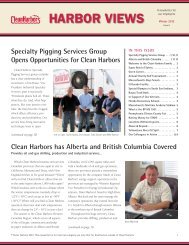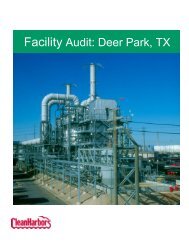Facility Audit: Deer Park, TX - Clean Harbors
Facility Audit: Deer Park, TX - Clean Harbors
Facility Audit: Deer Park, TX - Clean Harbors
You also want an ePaper? Increase the reach of your titles
YUMPU automatically turns print PDFs into web optimized ePapers that Google loves.
B. Faulting<br />
There are no faults crossing the <strong>Deer</strong> <strong>Park</strong> site, or the immediate vicinity. The Battleground<br />
fault, the nearest fault to the site, is located several miles to the south and southeast. Like most<br />
subsurface faults along the upper Texas Gulf Coast not associated with salt domes, the<br />
Battleground fault has an east-northeast trend, which generally parallels the coastline. The area<br />
is considered to have zero seismic activity.<br />
C. Surface Water Hydrology<br />
Intermittent streams and bayous are characteristic surface water features in the area surrounding<br />
the facility. The only surface water feature on the <strong>Deer</strong> <strong>Park</strong> property is a channelized portion of<br />
Tucker Bayou into which treated wastewater is discharged under the site's USEPA NPDES and<br />
TCEQ permits. Tucker Bayou flows to the north for approximately 1.5 miles where it discharges<br />
into the Houston Ship Channel.<br />
From a water quality perspective, the usage of Tucker Bayou water is limited. Tucker Bayou<br />
and the Houston Ship Channel are not used as sources for public water supply or for any<br />
recreational purposes.<br />
D. Groundwater/Historical Use/RFI<br />
Groundwater quality assessment activities were initiated in 1985, when statistical analysis of<br />
groundwater chemical data indicated contamination. Since then, extensive groundwater quality<br />
assessment studies and a RCRA <strong>Facility</strong> Investigation (RFI) have delineated the site's<br />
hydrogeology and groundwater make-up.<br />
Regional geological studies indicate that the Chicot and Evangeline aquifers are regional sources<br />
for drinking water and industrial process water. These two aquifers are located at 300 to 500 and<br />
620 to 1500+ feet below the surface. The facility has two industrial wells completed in the lower<br />
Chicot aquifer, and groundwater withdrawal is controlled by the Harris-Galveston County<br />
Coastal Subsidence District. Analytical results indicate no detectable contamination in these<br />
wells. The amount of groundwater pumped from these aquifers has no discernible hydraulic<br />
influence on shallow groundwater at the facility. Thick clay layers separate the deep drinking<br />
water from the monitored shallow sands.<br />
Past activities at the <strong>Deer</strong> <strong>Park</strong> facility resulted in groundwater contamination in three subsurface<br />
layers (Strata 1, 3, and 5). The contaminants of concern are chlorobenzene and a number of<br />
volatile organics. As a result of this contamination, in October 1987, <strong>Deer</strong> <strong>Park</strong> entered into an<br />
Administrative Agreed Order with the USEPA under 3008(h) of RCRA to perform corrective<br />
actions to close wastewater lagoons and an area of buried drums between the North and South<br />
Landfills, referred to as the Drum Remediation Area. The Corrective Action Plan called for<br />
implementation of Interim Corrective Measures; completion of a RCRA <strong>Facility</strong> Investigation<br />
(RFI); and a Corrective Measures Study. In 1988, when the TCEQ granted a Part B permit, the<br />
state stipulated that the site conduct an RFI. The regulators agreed that one RFI could be<br />
conducted to meet both requirements. The RFI Final Report was approved in June 1992.<br />
38




